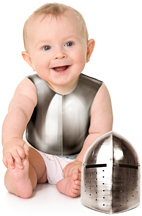To Your Health
December, 2008 (Vol. 02, Issue 12) |
|
|
Safety First
By Nancy Molina, DC
As any parent knows, keeping young children safe is a full-time job. Danger seems to lurk around every corner; everything from sharp objects and choking hazards when they're very young to broken limbs and bullies when they're a bit older. And what about every time you load them into a car and drive somewhere; how do you protect them from potential harm? It's all about safety first.
Injury is the number-one killer of children in the United States. In 2004, injury accounted for 59.5 percent of all deaths in children younger than 18 years of age. The financial burden to society of children who survive childhood injury with disability also continues to be enormous. According to a study in the April 2008 issue of Pediatrics, "Only the comprehensive cooperation of a broadly diverse group of people will have a significant effect on improving the care and outcome of injured children." That starts with parents, grandparents and adults in general ensuring children are as safe as they can possibly be every time they go anywhere in a motor vehicle.
 Sobering Statistics
Sobering Statistics
Motor vehicle crashes are the leading cause of death for children 2 to 14 years old, based on 2004 figures, which are the latest data currently available from the National Center for Health Statistics. In 2006, an average of five children ages 14 and younger were killed and 568 were injured every day in motor vehicle crashes. Injures suffered while riding in cars are the number-one preventable cause of death in young children. We all must make every effort to ensure children ages 0-16 are properly restrained in the correct restraint system for their age and size every time they travel in a motor vehicle. While great progress has been achieved in recent years in preventing child occupant deaths and injuries - and increasing the correct use of child safety seats, booster seats and safety belts - more work needs to be done to protect child occupants who remain at heightened risk.
Focus on Prevention
The magnitude of this problem demands that parents educate themselves as to the dangers children face, particularly the high-risk group of young children. Young children have delicate bodies and bone structures, and because they are light, may be easily thrown upon impact. In a low-speed crash, an infant or small child can smash into the windshield with the same force as if you dropped them from a third-story window.

